- Clone
- CXCR3-173 (See other available formats)
- Regulatory Status
- RUO
- Other Names
- CXCR3, G protein-coupled receptor 9 (GPR9), CKR-L2, IP10 receptor (IP10-R), Mig receptor (Mig-R )
- Isotype
- Armenian Hamster IgG
- Ave. Rating
- Submit a Review
- Product Citations
- publications
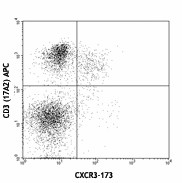
-

C57BL/6 splenocytes stained with purified CXCR3-173, followed by anti-Armenian hamster IgG FITC and anti-mouse CD3 (17A2) APC
| Cat # | Size | Price | Quantity Check Availability | Save | ||
|---|---|---|---|---|---|---|
| 126502 | 200 µg | 95€ | ||||
CD183, also known as CXCR3, is a member of the C-X-C chemokine family, characterized by a pair of cysteine residues separated by a single amino acid. CXCR3 is a 38 kD seven pass transmembrane receptor coupled to G-protein. It mediates Ca2+ mobilization and chemotaxis in response to C-X-C chemokines, such as IP10 (CXCL10), MIG (CXCL9), I-TAC (CXCL11) and PF4 (CXCL4). CXCR3 is expressed primarily on activiated T lymphocytes, NK cells, and some epithelial cells and endothelial cells. It is not expressed on B cells, monocytes, or granulocytes.
Product DetailsProduct Details
- Verified Reactivity
- Mouse
- Antibody Type
- Monoclonal
- Host Species
- Armenian Hamster
- Immunogen
- Mouse N-terminus of CXCR3
- Formulation
- Phosphate-buffered solution, pH 7.2, containing 0.09% sodium azide.
- Preparation
- The antibody was purified by affinity chromatography.
- Concentration
- 0.5 mg/ml
- Storage & Handling
- The antibody solution should be stored undiluted between 2°C and 8°C.
- Application
-
FC - Quality tested
Block - Reported in the literature, not verified in house - Recommended Usage
-
Each lot of this antibody is quality control tested by immunofluorescent staining with flow cytometric analysis. For flow cytometric staining, the suggested use of this reagent is ≤ 1.0 µg per 106 cells in 100 µl volume. It is recommended that the reagent be titrated for optimal performance for each application.
- Application Notes
-
Clone CXCR3-173 does not work for Western blotting.7 For in vivo studies or highly sensitive assays, we recommend Ultra-LEAF™ purified antibody (Cat. No. 126526) with endotoxin < 0.01 EU/µg, Azide-Free, 0.2 µm filtered.
-
Application References
(PubMed link indicates BioLegend citation) -
- Krug A, et al. 2002. J. Immunol. 169:6079.
- McAleer JP, et al. 2009. J. Immunol. 182:5322. PubMed
- Sharma R. 2009. J. Immunol. 183:3212. (FC) PubMed
- Barbi J, et al. 2009. FASEB J. 23:3990. PubMed
- Kimpfler S, et al. 2009. J. Immunol. 183:6330. PubMed
- Dürr C, et al. 2010. Cancer Res. 70:10170. (Block) PubMed
- Uppaluri R, et al. 2008. Transplantation 86:137.
- Product Citations
-
- RRID
-
AB_1027635 (BioLegend Cat. No. 126502)
Antigen Details
- Distribution
-
T cells, plasmacytoid dendritic cells, GM-CSF activated CD34+ hematopoietic progenitors
- Function
- Essential in T cell recruitment to sites of inflammation
- Cell Type
- Dendritic cells, Hematopoietic stem and progenitors, T cells
- Biology Area
- Immunology, Innate Immunity
- Molecular Family
- CD Molecules, Cytokine/Chemokine Receptors, GPCR
- Gene ID
- 12766 View all products for this Gene ID
- UniProt
- View information about CD183 on UniProt.org
Related FAQs
Other Formats
View All CD183 Reagents Request Custom Conjugation| Description | Clone | Applications |
|---|---|---|
| Brilliant Violet 510™ anti-mouse CD183 (CXCR3) | CXCR3-173 | FC |
| PE anti-mouse CD183 (CXCR3) | CXCR3-173 | FC |
| Biotin anti-mouse CD183 (CXCR3) | CXCR3-173 | FC |
| APC/Fire™ 750 anti-mouse CD183 (CXCR3) | CXCR3-173 | FC |
| Purified anti-mouse CD183 (CXCR3) | CXCR3-173 | FC,Block |
| APC anti-mouse CD183 (CXCR3) | CXCR3-173 | FC |
| PerCP/Cyanine5.5 anti-mouse CD183 (CXCR3) | CXCR3-173 | FC |
| PE/Cyanine7 anti-mouse CD183 (CXCR3) | CXCR3-173 | FC |
| Brilliant Violet 421™ anti-mouse CD183 (CXCR3) | CXCR3-173 | FC |
| Brilliant Violet 605™ anti-mouse CD183 (CXCR3) | CXCR3-173 | FC |
| Ultra-LEAF™ Purified anti-mouse CD183 (CXCR3) | CXCR3-173 | FC,Block |
| Brilliant Violet 650™ anti-mouse CD183 (CXCR3) | CXCR3-173 | FC |
| PE/Dazzle™ 594 anti-mouse CD183 (CXCR3) | CXCR3-173 | FC |
| FITC anti-mouse CD183 (CXCR3) | CXCR3-173 | FC |
| Alexa Fluor® 488 anti-mouse CD183 (CXCR3) | CXCR3-173 | FC |
| TotalSeq™-C0228 anti-mouse CD183 (CXCR3) | CXCR3-173 | PG |
| TotalSeq™-B0228 anti-mouse CD183 (CXCR3) | CXCR3-173 | PG |
| APC/Cyanine7 anti-mouse CD183 (CXCR3) | CXCR3-173 | FC |
Customers Also Purchased
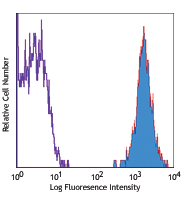
Compare Data Across All Formats
This data display is provided for general comparisons between formats.
Your actual data may vary due to variations in samples, target cells, instruments and their settings, staining conditions, and other factors.
If you need assistance with selecting the best format contact our expert technical support team.
-
Brilliant Violet 510™ anti-mouse CD183 (CXCR3)
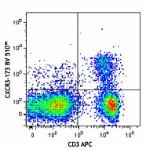
C57BL/6 mouse splenocytes were stained with CD3 APC and CXCR... 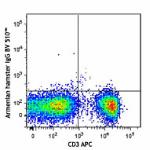
-
PE anti-mouse CD183 (CXCR3)
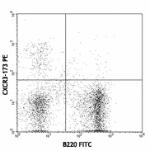
C57BL/6 splenocytes stained with CXCR3-173 PE and B220 FITC -
Biotin anti-mouse CD183 (CXCR3)
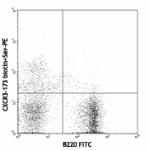
C57BL/6 splenocytes stained with B220 (RA3-6B2) FITC and CXC... -
APC/Fire™ 750 anti-mouse CD183 (CXCR3)
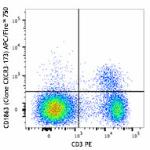
C57BL/6 mouse splenocytes were stained with CD3 PE and CXCR3... 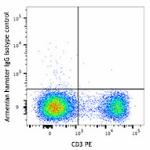
-
Purified anti-mouse CD183 (CXCR3)
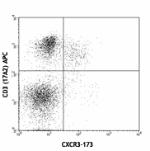
C57BL/6 splenocytes stained with purified CXCR3-173, followe... -
APC anti-mouse CD183 (CXCR3)
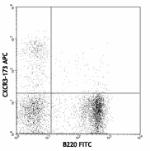
C57BL/6 splenocytes stained with B220 (RA3-6B2) FITC and CXC... -
PerCP/Cyanine5.5 anti-mouse CD183 (CXCR3)

C57BL/6 splenocytes were stained with CD3e APC and CD183 Per... -
PE/Cyanine7 anti-mouse CD183 (CXCR3)

C57BL/6 mouse splenocytes were stained with anti-mouse CD3&e... -
Brilliant Violet 421™ anti-mouse CD183 (CXCR3)
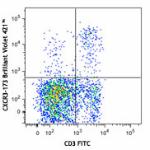
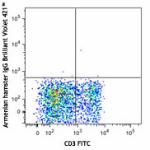
-
Brilliant Violet 605™ anti-mouse CD183 (CXCR3)
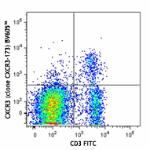
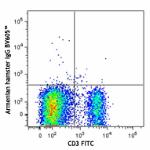
-
Ultra-LEAF™ Purified anti-mouse CD183 (CXCR3)

C57BL/6 splenocytes stained with purified CXCR3-173, followe... -
Brilliant Violet 650™ anti-mouse CD183 (CXCR3)
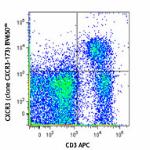
C57BL/6 mouse splenocytes were stained with CD3 APC and CXCR... 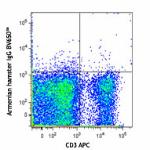
-
PE/Dazzle™ 594 anti-mouse CD183 (CXCR3)

C57BL/6 mouse splenocytes were stained with CD3 APC and CXCR... 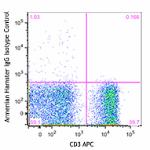
-
FITC anti-mouse CD183 (CXCR3)
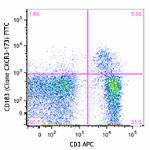
C57BL/6 mouse splenocytes were stained with CD3 APC and CXCR... 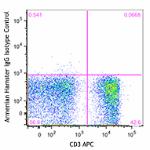
-
Alexa Fluor® 488 anti-mouse CD183 (CXCR3)
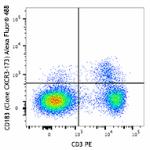
C57BL/6 mouse splenocytes were stained with CD3 PE and CXCR3... 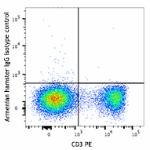
-
TotalSeq™-C0228 anti-mouse CD183 (CXCR3)
-
TotalSeq™-B0228 anti-mouse CD183 (CXCR3)
-
APC/Cyanine7 anti-mouse CD183 (CXCR3)

C57BL/6 mouse splenocytes were stained with anti-mouse CD3 F...
 Login / Register
Login / Register 





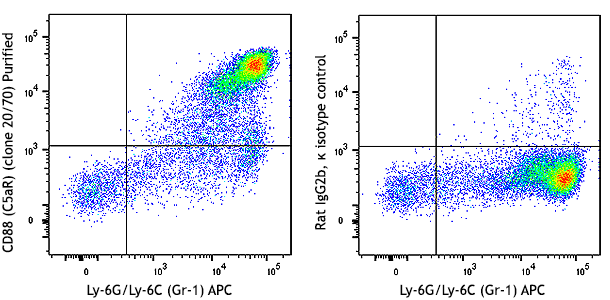
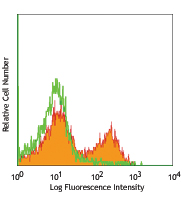
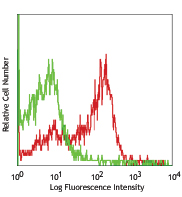



Follow Us